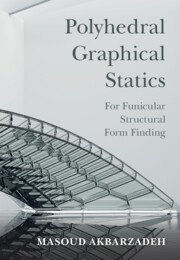Book contents
- Frontmatter
- Dedication
- Contents
- Contributors
- Foreword
- Foreword
- Preface
- Acknowledgments
- Introduction: A Brief History
- 1 Equilibrium of a Single Node
- 2 Equilibrium of a System of Forces
- 3 Compression-Only Form Finding
- 4 Articulated Compression-Only Forms
- 5 Systems with Combined Tension and Compression
- 6 Geometric Degrees of Freedom in Design of Form and Force Diagrams
- 7 Algebraic Formulation for Polyhedral Graphic Statics
- 8 Broader Applications of Polyhedral Graphic Statics
- References
- Index
4 - Articulated Compression-Only Forms
Published online by Cambridge University Press: 13 March 2025
- Frontmatter
- Dedication
- Contents
- Contributors
- Foreword
- Foreword
- Preface
- Acknowledgments
- Introduction: A Brief History
- 1 Equilibrium of a Single Node
- 2 Equilibrium of a System of Forces
- 3 Compression-Only Form Finding
- 4 Articulated Compression-Only Forms
- 5 Systems with Combined Tension and Compression
- 6 Geometric Degrees of Freedom in Design of Form and Force Diagrams
- 7 Algebraic Formulation for Polyhedral Graphic Statics
- 8 Broader Applications of Polyhedral Graphic Statics
- References
- Index
Summary
This chapter covers various topics on the design of funicular forms with an emphasis on particular features in the structural forms. It starts by introducing the topological and geometrical relationship between the form and force diagrams in 2D and 3D and describes nodal and global equilibrium in the context of both 2D and polyhedral graphic statics. It explains how to find closed polyhedral cells from a group of faces and the computational approach that could be used for this purpose. It argues the necessity of implementing computational tools to explore the realm of intricate funicular forms with pronounced design features. To give instances of how computational implementation can help in design, various design examples are introduced, and their related design topics are explained. Note that the design domain in this approach is the force diagram. Thus all these design features are explained with respect to techniques of design incorporated in the force diagram that gives the desired feature in the funicular form. In the end, the translation of the cellular to shellular systems is explained and discussed as an interesting design approach that results in a more resilient structural form by creating anticlastic curvature in three-dimensional space.
- Type
- Chapter
- Information
- Polyhedral Graphical StaticsFor Funicular Structural Form Finding, pp. 175 - 233Publisher: Cambridge University PressPrint publication year: 2025

